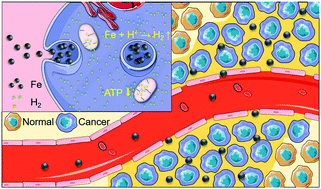Acid-responsive H2-releasing Fe nanoparticles for safe and effective cancer therapy†
Abstract
Hydrogen therapy is an emerging and promising strategy for treatment of inflammation-related diseases owing to the excellent bio-safety of hydrogen molecules (H2), but is facing a challenge that the H2 concentration at the local disease site is hardly accumulated because of its high diffusibility and low solubility, limiting the efficacy of hydrogen therapy. Herein, we propose a nanomedicine strategy of imaging-guided tumour-targeted delivery and tumour microenvironment-triggered release of H2 to address this issue, and develop a kind of biocompatible carboxymethyl cellulose (CMC)-coated/stabilized Fe (Fe@CMC) nanoparticle with photoacoustic imaging (PAI), tumour targeting and acid responsive hydrogen release properties for cancer therapy. The Fe@CMC nanoparticles have demonstrated high intratumoural accumulation capability, high acid responsiveness, excellent PAI performance, selective cancer-killing effect and high bio-safety in vitro and in vivo. Effective inhibition of tumour growth is achieved by intravenous injection of the Fe@CMC nanoparticles, and the selective anti-cancer mechanism of Fe@CMC is discovered to be originated from the energy metabolism homeostasis regulatory function of the released H2. The proposed nanomedicine-mediated hydrogen therapy strategy will open a new window for precise, high-efficacy and safe cancer treatment.

- This article is part of the themed collection: 2019 Journal of Materials Chemistry B Most Popular Articles


 Please wait while we load your content...
Please wait while we load your content...